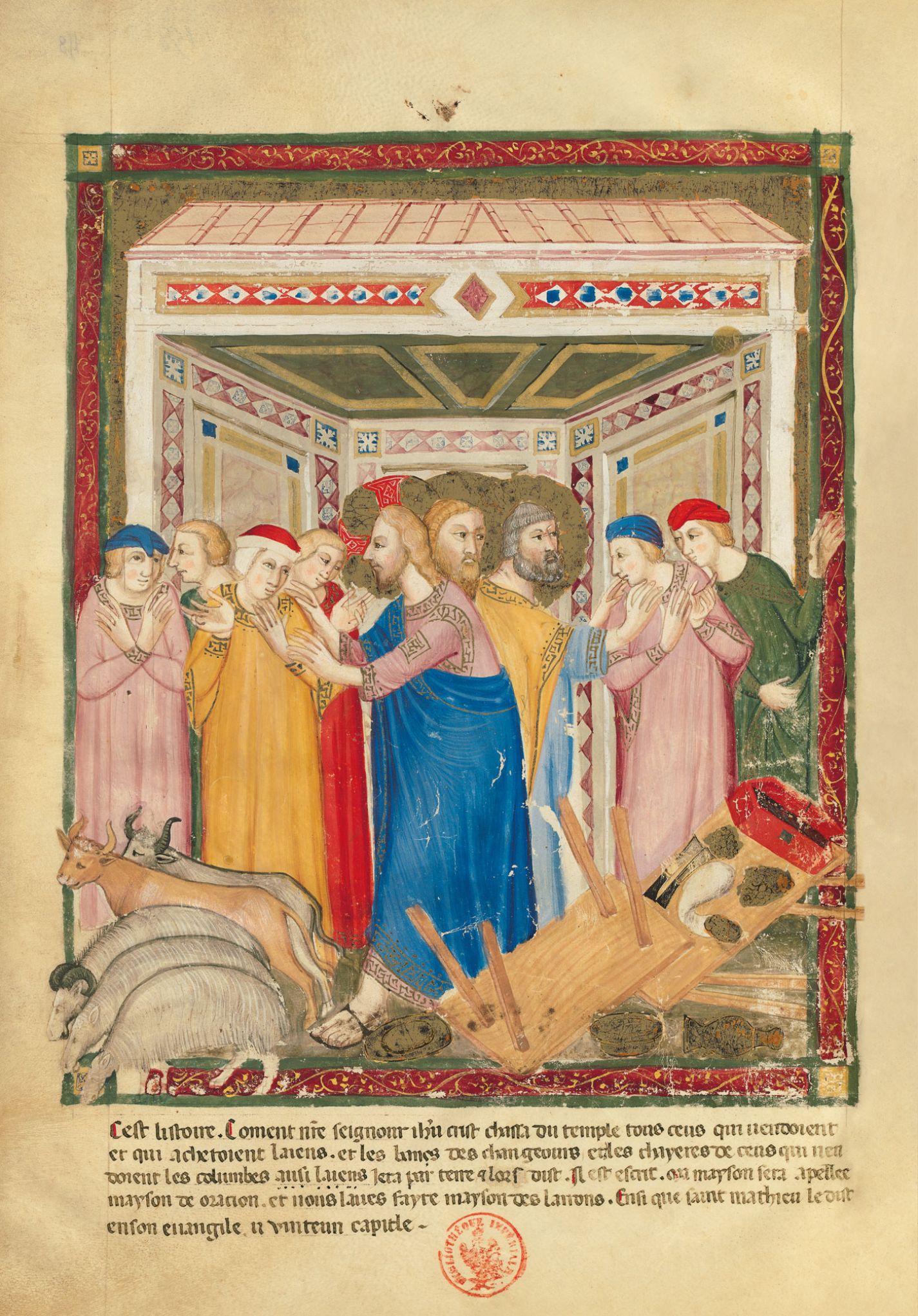“This is the story. How Our Lord Jesus Christ cast out of the Temple all those who were buying and selling there, and he overthrew the benches of the moneychangers and the chairs of the dove sellers [also there corrected by expunction ] and said to them: It is written: my house shall be called a house of prayer and you have made it a house of thieves. Thus says Saint Matthew in his Gospel in the twenty-first chapter.”
Jesus has entered Jerusalem. The four Gospels tell how the vendors were cast out of the temple, but the paraphrase uses Matthew’s words as a legend for the illustration of Christ’s rage when he accuses the vendors of transforming his house into a “den of thieves”.
Painter A provides a relatively gentle view of the episode in comparison with the violent version in the Arena chapel in Padua in which Giotto depicts the Lord shaking his fist at the thieves installed in the temple forecourt. In our Bible, however, all religious vestiges have been removed from the temple backdrop and it resembles the home of the rich man (f. 155r) but without the pediment – as if the trading activities had temporarily corrupted its walls. The imposing figures and huge haloes of Christ and two disciples occupy the centre of the room. Facing all directions like a Trinitarian figure, they cast the undesirables out. Jesus drives the cattle vendors away to the left and they retreat with their herds, looking contrite and shrugging in apology. The sheep and cows tread on the frame as if about to exit the image. Lying on the floor in the foreground on the right are the moneychangers’ tables and the valuable booty – gold plate and coins, knives and a collection of medals (?) – left behind by two stallholders preferring to back off as Peter pushes them hard with his hands. The dove sellers mentioned in the text are nowhere to be seen. It must be said that there is not much room and that the double V created by the diagonals of the animals and tables at the bottom of the composition, and the vanishing points that converge at the bottom are enough to create an eloquent climate of tension: the space closes in all the better to expel the men of little faith from the holy place.
Yves Christe
University of Geneva
Marianne Besseyre
Illuminated Manuscripts Research Center, Bibliothèque nationale de France
Fragment of the Bible moralisée of Naples commentary volume

“This is the story. How Our Lord Jesus Christ cast out of the Temple all those who were buying and selling there, and he overthrew the benches of the moneychangers and the chairs of the dove sellers [also there corrected by expunction ] and said to them: It is written: my house shall be called a house of prayer and you have made it a house of thieves. Thus says Saint Matthew in his Gospel in the twenty-first chapter.”
Jesus has entered Jerusalem. The four Gospels tell how the vendors were cast out of the temple, but the paraphrase uses Matthew’s words as a legend for the illustration of Christ’s rage when he accuses the vendors of transforming his house into a “den of thieves”.
Painter A provides a relatively gentle view of the episode in comparison with the violent version in the Arena chapel in Padua in which Giotto depicts the Lord shaking his fist at the thieves installed in the temple forecourt. In our Bible, however, all religious vestiges have been removed from the temple backdrop and it resembles the home of the rich man (f. 155r) but without the pediment – as if the trading activities had temporarily corrupted its walls. The imposing figures and huge haloes of Christ and two disciples occupy the centre of the room. Facing all directions like a Trinitarian figure, they cast the undesirables out. Jesus drives the cattle vendors away to the left and they retreat with their herds, looking contrite and shrugging in apology. The sheep and cows tread on the frame as if about to exit the image. Lying on the floor in the foreground on the right are the moneychangers’ tables and the valuable booty – gold plate and coins, knives and a collection of medals (?) – left behind by two stallholders preferring to back off as Peter pushes them hard with his hands. The dove sellers mentioned in the text are nowhere to be seen. It must be said that there is not much room and that the double V created by the diagonals of the animals and tables at the bottom of the composition, and the vanishing points that converge at the bottom are enough to create an eloquent climate of tension: the space closes in all the better to expel the men of little faith from the holy place.
Yves Christe
University of Geneva
Marianne Besseyre
Illuminated Manuscripts Research Center, Bibliothèque nationale de France
Fragment of the Bible moralisée of Naples commentary volume